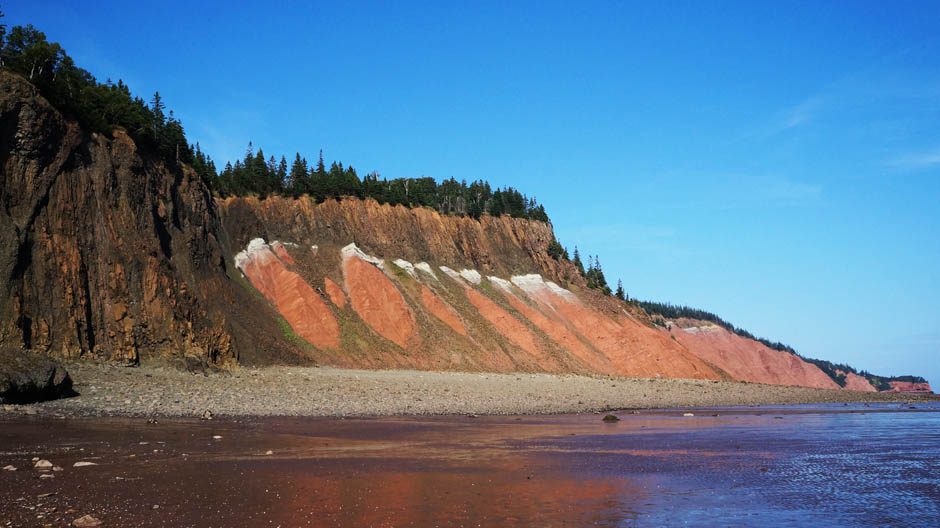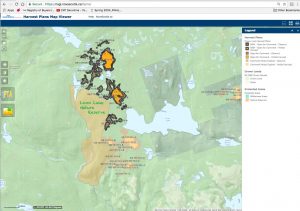DNR responds to concerns about cuts in the Loon Lake area; Saunders says using toilet paper makes us all hypocrites
While one purpose of the posts on this website is “to serve as a record of events, news and opinions on the subject of forests and forestry in Nova Scotia as they unfold, beginning on June 21, 2016”, I do not try do this on a day by day basis. Often a post about a news item is made well after the news item appeared especially if I have substantial comments to make about it.
A couple of items have come up between yesterday and today related to the DNR response to the Loon Lake area cuts*:
– Province responds to concerns about forestry practice
CBC Information Morning on Friday, March 2, 2018. Bruce Stewart, DNR Manager of Forest Research and Planning, and Mark Pulsifer a Wildlife Biologist and Regional Resource Manager, Eastern Division with NSDNR, were interviewed by Norma Lee MacLeod on the topic of recent cutting of old yellow birch in the area of the Loon Lake Nature Reserve as highlighted by Danny George.– DNR checking into allegations old growth trees cut
by Aaron Berwick fr Chronicle Herald, March 3, 2018
I do want to comment on the DNR response but I need some more time to sort it all out, e.g., for one, to be clear on exactly where the cuts are located. I have listened to the Info-AM interview. An abbreviated transcript is given below.
Gary Saunders is also back at it:
COMMENTARY: Canadians hypocrites when it comes to our forests
Chronicle Herald, Mar 2, 2018Says Saunders:
Markets are where we come in. “We” can be Asians, Europeans, Americans, Canadians. Of the four, we rank near the top of paper users and wasters — and near the bottom of world paper recyclers.
One example: toilet tissue. Each of us flushes away at least a roll a week. For Nova Scotians alone, that’s roughly 50 million a year. Unless we switch to moss (Indigenous moms successfully diapered their babies with green peat moss), I don’t see a solution. Never mind Poise pads for aging Yuppies and Pampers for Gen X’s babies.
Well I’m glad to hear that there is such a firm market for our pulp mills. I had thought that a lot of the pressure to find others uses for our low value wood such as biomass energy, bioplastics and the like produced by CO2-emitting technologies was related to declining markets for pulp and paper and increased competition from areas with faster growing plantation trees and use of other feedstocks.
Woods and Waters Nova Scotia keeps a tab on current forestry news and facilitates discussion
Mike Parker’s posts about Nova Scotia forestry news on Woods and Waters Nova Scotia are in general much more timely than my posts and he often posts items I would not have seen otherwise so I recommend WWNS as a place to keep up day to day. He makes a post about most of the items that I discuss on my posts and he facilitates discussion of posts so it’s also a good place to make comments/carry on a moderated discussion about any of my posts.
__________________________________________________
*Recent posts on this topic:
– Danny George rings the alarm bell (again) on Loon Lake Nova Scotia clearcuts of Old Growth
Post of February 23, 2018– PHP to issue a public response to concerns about harvesting near Loon Lake Nature Reserve
Post March 1, 2018
______________________________________________________________________________
Abbreviated transcript for the Information Morning interview with DNR personnel on Loon Lake area cuts (CBC, March 2, 2018):
A note about the “abbreviated transcripts”. I post transcripts of interviews as a matter of record, a prime objective of this blog being to keep track of Nova Scotia forestry in the news. One can listen to the interviews, but in this rushed world it’s faster to read the transcript, albeit you miss some of the nuances. It is not Hansard, and for the sake of getting though it in less than a day the transcript is not always precise, but I attempt not to change the essence of what is said in any way, and one can always check out the audio files. I also do it because it makes me listen carefully to what is being said, whether I like what’s being said or not. That’s often hard to do. In general in this blog I highlight ver batim statements from Nova Scotia government personnel in brown.
CBC Into: This week on Information Morning [Nova Scotia], we heard from Daniel George, he’s been harvesting trees in NS for more than 40 years, he has been speaking out about the ways trees are cut on Crown Land. He is particularly concerned about harvesting an old growth hardwood forest in Guysborogh Co. …. “Part of the problem with cutting in hardwoods today is they are not using the right system in order to minimize the footprint, to encourage regeneration of the species that are here today that are the desirable species. This type of harvest will encourage regeneration of the low grade products and ironically those are the products that are really biomass….the long term goal of the biomass is to have a feedstock close to the mill… So the treatment they are doing will encourage more of that type of product which is the lowest value commodity in the forest.” NS’s DNR oversees the management of Crown Land forests. Bruce Stewart is the department’s manager of Forest Research and Planning; Mark Pulsifer ths ithe Regional Resource Manager for DNR.
CBC’s Norma Lee McLeod: Bruce.. Daniel George says this is an Old Growth Forest. Is it?
BS: Our planning systems before we started assessing those stands didn’t indicate there was any old growth forest in that area.. after this story came to light, we sent our old forest specialist down to that area with the regional forester and there are certainly mature forests and large trees in that area, so we are going to go down, use our old forest scoring system which we use to evaluate the qualities of Old Growth forests and do an assessment of all of those stands and determine but at this point we don’t have any indication that is in fact old growth.
NLM: But you are not sure when that assessment will be done; if it turns it is an Old Growth forest, this shouldn’t have happened; how could it have happened?
BS: if [so]..we will be asking that question as well…at this point we don’t have any indication. We do have a very comprehensive old forest policy and conservation program…we do in that ecodistrict have almost twice as much Old Growth forest protected right now than the target…we have almost 27,000 ha protected. And we have some very good stands in the Loon Lake area that are protected in the Nature Reserve.
So at this point certainly there are mature forest trees that may contribute mature forest values but until we do that assessment we have no indication that those stands are old growth.
NLM: So It is possible that it could have been mis-categorized. If so, could there be more…is there a review if Old Growth forest that you should be doing – to ensure forestry is only happening where it is supposed to happen?
BS: Well, regarding Old Growth forest conservation we have been pursuing a policy to find the best Old Growth for the last 20 years, the regional foresters are assessing forests all of the time. They have pretty much completed the target levels in all ecodistricts. However, there is always the chance of finding a forest you didn’t expect to be there.
Our PTA process mandates that every site is visited on the ground before it starts… it’s a fairly new process. It has a flag in it that will identify any mature forest that has a potential to be old growth which would cause that stand to be assessed with the Old Growth scoring system before it’s treated.
NLM: So Mark, did that happen in this case?
MP: We did not recognize any particular triggers that came with respect to the potential for old forest in there. We have a couple of different processes that we use, a desktop planning process that did not indicate any Old growth elements or characteristics there. We followed that up with some ground work through this pre-treatments process, and it did not pick up any thing either at this time.
NLM: I want to ask you about the way DG describes how loggers are cutting trees in this particular area. He says the swaths are too wide, that brings too much light into the forest and as a result the most valuable wood, the shade tolerant species are not going to grow back.. his accusation is that it makes the perfect spot to produce biomass.
MP: I would say that’s not entirely correct. The trail system that’s in there with this particular groupselection does promote yellow birch regeneration which is the predominant tolerant species we are talking about here. Basically the action of scarifying the ground and doing what is required there is enough to promote that yellow birch..you may get the odd other species in there..Yellow birch is the target and we are quite confident based on our forest plan that we are going to get that back.
NLM: so you feel this will regenerate with valuable hardwood, not biomass.
MP: It will. It definitely will. There is a variety of products out there in the forest at any point in time and biomass is only one of them. There are several other categories of hardwood production, everything from veneer logs to sawlogs to hardwood pulp to pallet wood and as well there is biomass there. So biomass is only one small part of the total package is available.
NLM: We are running out of time… Bruce can you tell us how much money the province is getting from this cut per hectare,
BS: I can tell you that the processes DNR uses to manage forests are aimed at getting themmx9mum value over the long term by increasing the proportion of sawlogs that are on the site. It means we have to harvest some good and some poor quality to continually improve it..and the products are marketed to sawlogs if they are available, they are marketed for sawlogs if they are available, pallet wood, firewood a whole bunch of different markets.
NLM: But are you able to give us a number per acre?
BS: I can tell you the stumpage rates are set every year and they are based on the private land product prices that are available in the private sector. I cant tell you exactly what they are but they reflect those prices.
NLM: …we will have to leave it there…

